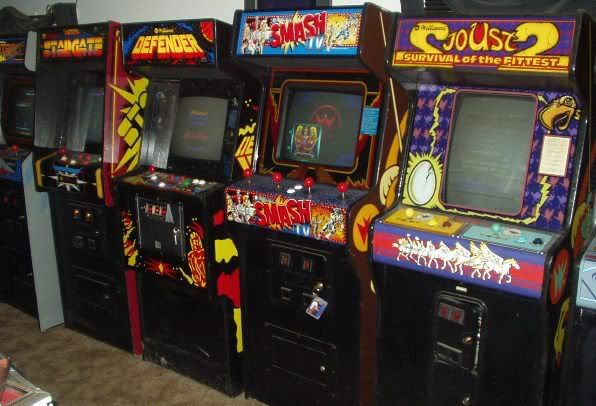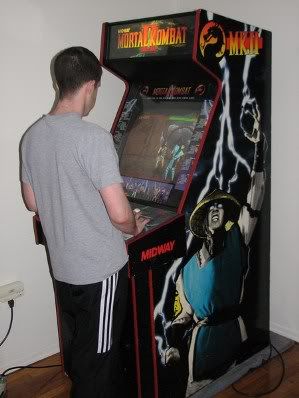
I find it peculiar that the more advances we make in communications, the less connected we truly are. Social gatherings have become a mark on the proverbial headboard as opposed to an experience.
Walk into a bar, and you see heads bowed and hands clasped — people praying en masse to their digital outlet, updating their status to reflect how much fun they are having. Attendance, alone, has eschewed interaction. Group settings have become LAN parties, but instead of connecting to each other, attendees connect externally through their communal filters.
Global communications and the internet, while invaluable assets, have afforded people the opportunity to isolate themselves from tangible communities. Gaming has undergone a drastic metamorphosis because of this.
When I was growing up, multiplayer games were played one of two ways: on the couch or in the arcade. Friends would gather in the same room for heated matches of Super Mario Kart or Street Fighter II. Instead of rushing home from school to upload your consciousness into the XBLA collective, you would go over to Johnny’s house, where Mike, Tommy, and Danny were headed, as well, to play some NBA Jam.
 In the summer of 1993 though, Johnny’s house was as silent as a crypt. Mike’s house was vacant, and tumbleweeds rolled with abandon through Danny’s neighborhood. Mortal Kombat II had hit arcades like an apocalyptic meteor, and every kid in town was gathered around that magical box, simulating acts of wanton violence against one another. Challenges were presented and rivalries formed, with faces you recognized and names you knew.
In the summer of 1993 though, Johnny’s house was as silent as a crypt. Mike’s house was vacant, and tumbleweeds rolled with abandon through Danny’s neighborhood. Mortal Kombat II had hit arcades like an apocalyptic meteor, and every kid in town was gathered around that magical box, simulating acts of wanton violence against one another. Challenges were presented and rivalries formed, with faces you recognized and names you knew.
But arcades, once the pinnacle of cutting-edge graphics and sound, eventually gave up the ghost. Home consoles had begun to match and surpass the capabilities of those machines, and the arcade became an archaic afterthought. Multiplayer gaming still flourished in the living room and the bedroom, though.
Even in 2004, local multiplayer was still the standard. Johnny, Mike, and Tommy were all grown now, but they still spent their gaming hours together, smoking copious amounts of pot and fragging each other in Halo 2.
As time passed, broadband became more accessible and consoles more accommodating to online gaming. It became more convenient for people to find companions online than it was to convene in person. With a couple of button presses, you could've been connected to thousands of people playing the same game you were.
 As with the internet in general, the anonymity afforded by networked gaming cultured an environment where social repercussions were diminished. Racist, homophobic, misogynistic, and abusive behavior went primarily unchecked. The most significant tradeoff has been the loss of face-to-face social interaction, though.
As with the internet in general, the anonymity afforded by networked gaming cultured an environment where social repercussions were diminished. Racist, homophobic, misogynistic, and abusive behavior went primarily unchecked. The most significant tradeoff has been the loss of face-to-face social interaction, though.
Most games only accommodate online play, and local multiplayer has gone by the wayside. Surely developers would be more accommodating if the demand was higher, but gamers seem rather apathetic — especially those from a younger generation.
Perhaps I am simply a dinosaur — an archaic relic clutching to nostalgia. I both enjoy and see the merits in online gaming, and obviously I involve myself in online communities. I do, however, long for the enjoyment of sharing a couch with my adversaries and companions. Games like Little Big Planet, Rayman Origins, and Borderlands provide an excellent outlet for local options, but it seems that titles featuring offline multiplayer are becoming scarce.
I sincerely hope that there are others out there who feel the same desire for local multiplayer. It would be nice to know that I’m not alone. I’m likely just an old fogey, sitting on my porch with my straw hat, waggling my cane in the air while I tell those kids to "get off my goddamned lawn."
J.C. Wigriff is a writer, columnist, musician, and admin of www.JCWigriff.com.
Follow him on Twitter @JCWigriff
VentureBeat's mission is to be a digital town square for technical decision-makers to gain knowledge about transformative enterprise technology and transact. Learn More
